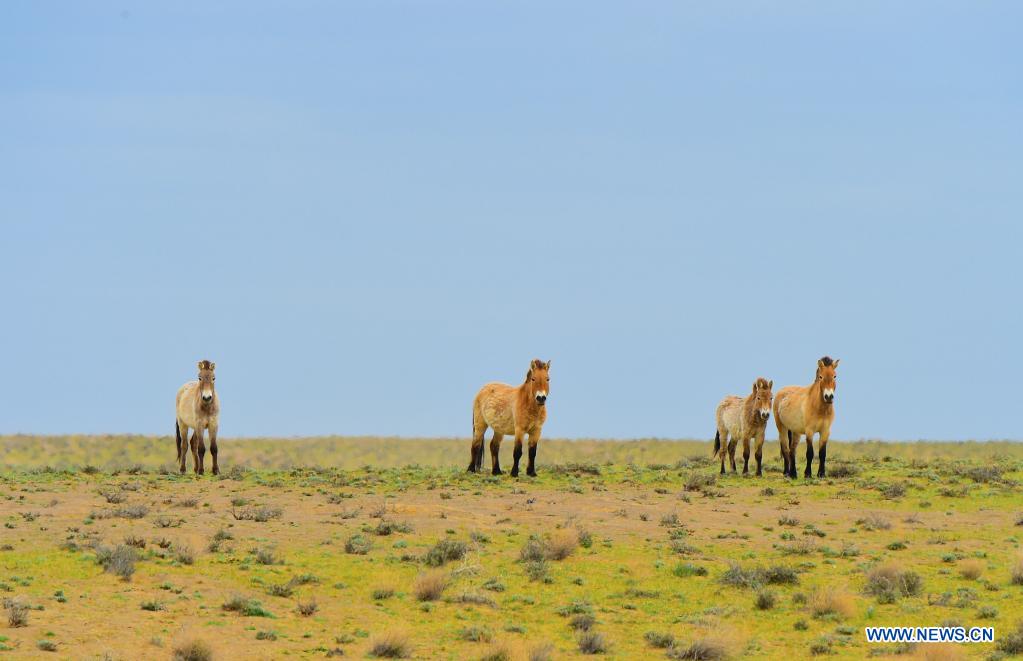National park project boosts desert biodiversity in China's Xinjiang


URUMQI -- Amid the heat of summer, a herd of Przewalski's horses roams among the low desert hills of the Karamaile Mountain Nature Reserve in Northwest China's Xinjiang Uygur autonomous region. A few kilometers away, 42-year-old ranger Adebyet climbs onto his pickup truck and peers through his binoculars.
"Eighteen horses in total: one adult male, eight adult females, six subadults, three foals," he tells his colleague, who notes down the figures.
"Let's go, they're all doing well. We shouldn't get any closer," says Adebyet, jumping down from the truck.
The Karamaile Mountain Nature Reserve they patrol is the native habitat of the Przewalski's horse, which is a species under first-class national protection. It is also home to many endangered wild animals, including Mongolian wild asses, goitered gazelles and argali sheep.
Characterized by desert plant species such as Haloxylon ammodendron and Calligonum mongolicum, as well as extensive Yardang landforms, the nature reserve is a typical example of temperate desert ecosystems worldwide.
It is one of the 49 national park candidate areas identified in a spatial layout plan for China's national parks jointly issued by four national bureaus in 2022. The planned park encompasses the Karamaile Mountain Nature Reserve, the Qitai fossilized wood and dinosaur national geological park, and the Qitai fossilized wood national desert park in Xinjiang, with a total area of approximately 14,700 square km.
According to the region's forestry and grassland bureau, the practical work of creating the Karamaile National Park has already been completed. With the third-party evaluation work done, it is now awaiting approval for official designation as a national park.
The distinction between a nature reserve and a national park is a subtle but important one. The Karamaile Mountain Nature Reserve is focused on "closed protection," while the creation of a national park emphasizes the integration of ecological conservation, green development and the improvement of people's livelihoods.
The work of improving the natural environment at the nature reserve has been going on for years, but the additional effort of making it national park has injected new vitality into its biodiversity protection efforts. The reserve has become a fine illustration of China's practice of harmonious coexistence between humanity and nature.
By the end of 2022, the total number of Przewalski's horses in Kalamayli reached 332, with over 3,400 Mongolian wild asses and more than 11,200 goitered gazelles. The comprehensive vegetation coverage has increased from 8.2 percent in the previous year to 8.4 percent, according to the latest monitoring results from the Xinjiang Institute of Ecology and Geography under the Chinese Academy of Sciences.
"Now is the foaling season, and the foals may be suckling or have weak bodies. During patrols, we try our best not to disturb them," said Adebyet, adding that the continuous improvement of their habitat has boosted the Przewalski's horse population, while allowing them to be more independent. "In the past, the wild horse herds would occasionally come to us in winter for 'help,' but now it happens less and less."
Przewalski's horses were once extinct in the Karamaile area. In 1985, China started bringing them back from overseas for breeding purposes, and in 2001, they were released into the Karamaile Mountain Nature Reserve for the first time.
In recent years, Xinjiang has continuously conducted special ecological environment restoration and remediation work in the Karamaile reserve.
Karamaile Mountain, which means "black mountain" in Kazakh, is rich in energy resources such as coal and oil. The Karamaile Mountain Nature Reserve, established in 1982, underwent multiple unauthorized reductions in size, gradually turning the protected area into a "development zone," with its area reduced by about one-third at one point.
Now, due to effective rectification and potent governance, the protected area has not only returned to its original size, but has also witnessed a significant increase in the population of wildlife species.
In December 2018, all oil production activities within the protected area were completely ceased, and 284 oil wells were permanently sealed, with their surfaces restored, according to Xinjiang Oilfield Company.
Ayjan Erkin is a young researcher at the nature reserve who has been inspired by plans to establish Xinjiang's first national park. She studied for six years at Northeast Forestry University in Harbin, Heilongjiang Province, majoring in wildlife and nature reserve management. After graduation, she returned to her hometown in Xinjiang and began supporting the reserve's work.
"The purpose of building hospitals is to enable people to recover from illnesses in the short term, but establishing nature reserves and national parks allows us to have a permanently safe living environment," says Ayjan Erkin.
"We are putting great effort into promoting scientific education and building information platforms to help the public understand the value of wildlife and plant conservation," she said.
MOST POPULAR
- 1 China to continue opening up its mega-market to world: premier
- 2 Policies concerning expats, foreign enterprises in November 2025
- 3 China to enhance convenience for inbound tourism: minister
- 4 Departure tax refund applications surge 285% as inbound tourism rebounds
- 5 China's foreign trade up 3.6% in first 11 months of 2025







